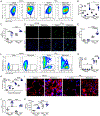Myeloid Heterogeneity Mediates Acute Exacerbations of Pulmonary Fibrosis
- PMID: 37782053
- PMCID: PMC10843506
- DOI: 10.4049/jimmunol.2300053
Myeloid Heterogeneity Mediates Acute Exacerbations of Pulmonary Fibrosis
Erratum in
-
Correction: DX5/CD49b-Positive T Cells Are Not Synonymous with CD1d-Dependent NKT Cells.J Immunol. 2024 Apr 15;212(8):1393. doi: 10.4049/jimmunol.2400069. J Immunol. 2024. PMID: 38407351 No abstract available.
Abstract
Epidemiological evidence indicates that exposure to particulate matter is linked to the development of idiopathic pulmonary fibrosis (IPF) and increases the incidence of acute exacerbations of IPF. In addition to accelerating the rate of lung function decline, exposure to fine particulate matter (particulate matter smaller than 2.5 μm [PM2.5]) is a risk factor for increased mortality in subjects with IPF. In this article, we show that exposure to PM2.5 mediates monocyte recruitment and fibrotic progression in mice with established fibrosis. In mice with established fibrosis, bronchoalveolar lavage cells showed monocyte/macrophage heterogeneity after exposure to PM2.5. These cells had a significant inflammatory and anti-inflammatory signature. The mixed heterogeneity of cells contributed to the proinflammatory and anti-inflammatory response. Although monocyte-derived macrophages were recruited to the lung in bleomycin-injured mice treated with PM2.5, recruitment of monocytes expressing Ly6Chi to the lung promoted progression of fibrosis, reduced lung aeration on computed tomography, and impacted lung compliance. Ly6Chi monocytes isolated from PM2.5-exposed fibrotic mice showed enhanced expression of proinflammatory markers compared with fibrotic mice exposed to vehicle. Moreover, IPF bronchoalveolar lavage cells treated ex vivo with PM2.5 showed an exaggerated inflammatory response. Targeting Ly6Chi monocyte recruitment inhibited fibrotic progression in mice. Moreover, the adoptive transfer of Ly6Chi monocytes exacerbated established fibrosis. These observations suggest that enhanced recruitment of Ly6Chi monocytes with a proinflammatory phenotype mediates acute exacerbations of pulmonary fibrosis, and targeting these cells may provide a potential novel therapeutic target to protect against acute exacerbations of IPF.
Copyright © 2023 by The American Association of Immunologists, Inc.
Figures






References
-
- Landrigan PJ, Fuller R, Acosta NJR, Adeyi O, Arnold R, Basu NN, Balde AB, Bertollini R, Bose-O'Reilly S, Boufford JI, Breysse PN, Chiles T, Mahidol C, Coll-Seck AM, Cropper ML, Fobil J, Fuster V, Greenstone M, Haines A, Hanrahan D, Hunter D, Khare M, Krupnick A, Lanphear B, Lohani B, Martin K, Mathiasen KV, McTeer MA, Murray CJL, Ndahimananjara JD, Perera F, Potocnik J, Preker AS, Ramesh J, Rockstrom J, Salinas C, Samson LD, Sandilya K, Sly PD, Smith KR, Steiner A, Stewart RB, Suk WA, van Schayck OCP, Yadama GN, Yumkella K, and Zhong M. 2018. The Lancet Commission on pollution and health. Lancet 391: 462–512. - PubMed
-
- Vohra K, Vodonos A, Schwartz J, Marais EA, Sulprizio MP, and Mickley LJ. 2021. Global mortality from outdoor fine particle pollution generated by fossil fuel combustion: Results from GEOS-Chem. Environ. Res 195: 110754. - PubMed
-
- Fann N, Lamson AD, Anenberg SC, Wesson K, Risley D, and Hubbell BJ. 2012. Estimating the national public health burden associated with exposure to ambient PM2.5 and ozone. Risk Anal. 32: 81–95. - PubMed
Publication types
MeSH terms
Substances
Grants and funding
LinkOut - more resources
Full Text Sources

